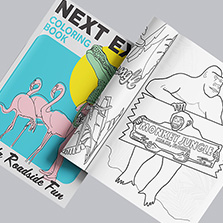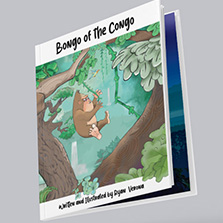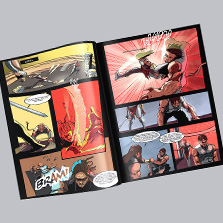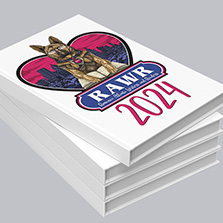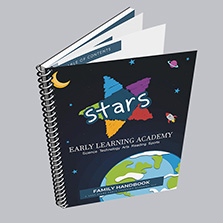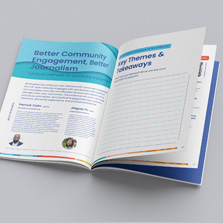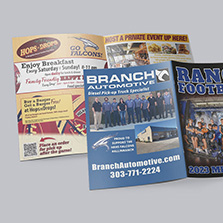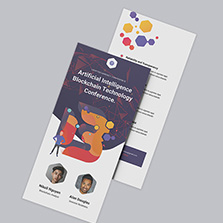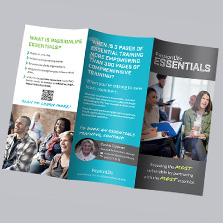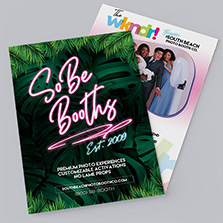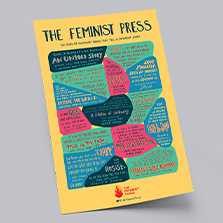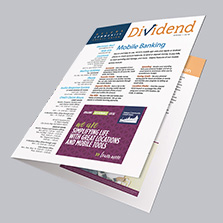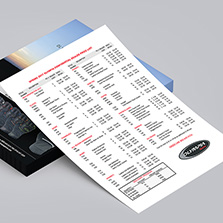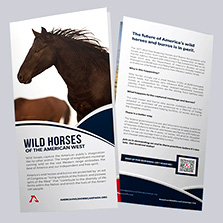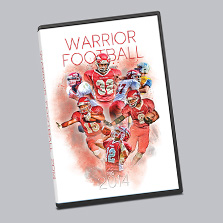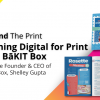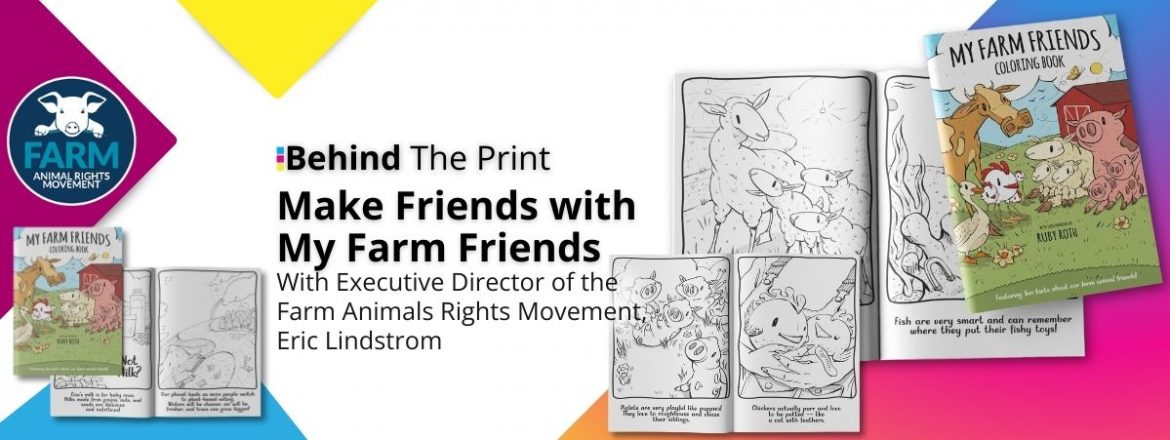
Behind The Print: Farm Animal Rights Movement
Welcome to the latest episode of Behind The Print, where we bring you the creative stories of industry leaders shaping the world of professional printing. In this episode of Behind The Print, we are sitting down with Eric Lindstrom, Executive Director of the Farm Animal Rights Movement (FARM). From reimagining traditional outreach with colorful, heartfelt print materials to building a compassionate movement one conversation at a time, Eric shares how storytelling, education, and print come together to create lasting change. Whether you are a nonprofit leader, small business owner, or just curious about how print fuels powerful causes, this conversation will leave you inspired.
Below, you’ll find the transcript of our conversation, edited for clarity to ensure easy reading. If you want the full, authentic experience, make sure to check out the video attached below.
11-minute read
“And these, whether it’s a brochure or the coloring book, which we’ll talk about in a second, print has played a huge part in what we do, and it always has. And while others may think that print is dead, and favor toward apps or their iPhones or any other digital media, you still can’t beat handing somebody a brochure.” Eric Lindstrom, Executive Director
Transcripts from Behind The Print with Eric Lindstrom, Executive Director of FARM, the Farm Animal Rights Movement
Welcome back to Behind The Print podcast, where we feature industry leaders and uncover the creative minds behind businesses in the professional printing world. Our mission is to provide you with inspiring, actionable resources to elevate your business projects and accelerate your journey to excellence in profit and print.
Today’s episode is Make Friends With My Farm Animals, and I’m here today with Executive Director of the Farm Animal Rights Movement, Eric Lindstrom.
Eric Lindstrom: Hi Zoe, thank you for having me on.
Zoe Fisher: Of course, Eric! I’m so glad to get to talk with you about all your adventures and about the foundation itself.
Eric Lindstrom: Sure, definitely. Ask away if you have any questions.
Zoe Fisher: Yeah! So, can you introduce us to FARM and tell us what you do as Executive Director?
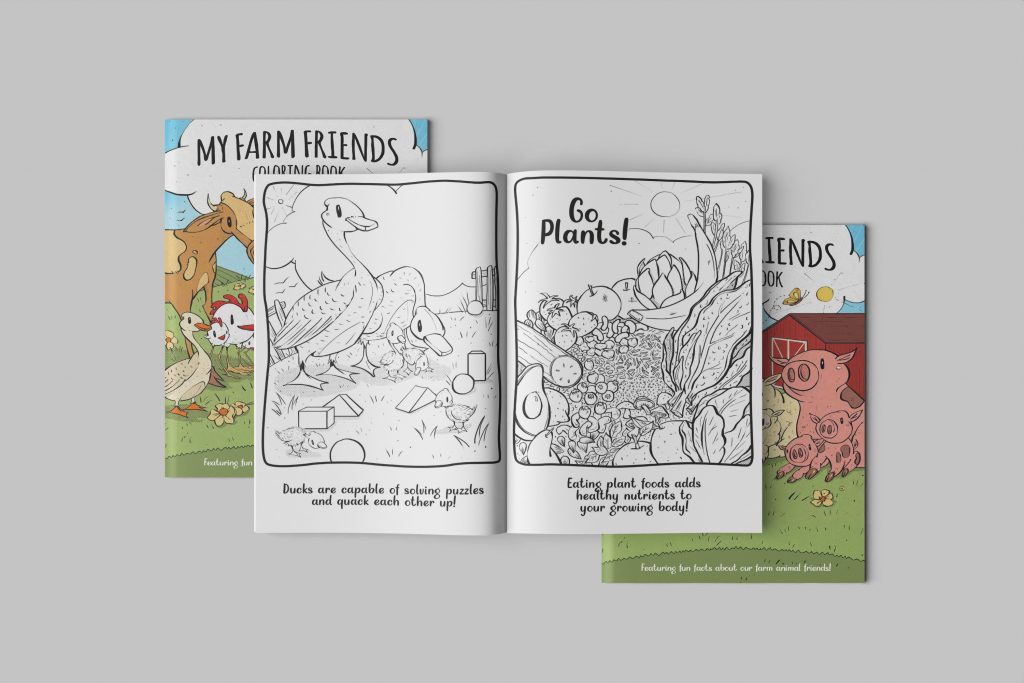
Eric Lindstrom: FARM, or Farm Animal Rights Movement, is the nation’s oldest animal rights organization dedicated to ending the use of animals for food. We were founded nearly 50 years ago in Washington, DC.
Our mission since 1976 has been simple: end the use of animals for food. All of our programming and events support people adopting a plant-based diet, for human health, for the environment, and most importantly, for the animals.
“Very few people go vegan overnight. Our approach is providing educational resources through events, demonstrations, and outreach, mainly targeting young people who are still impressionable and passionate about saving the environment.” Eric Lindstrom, Executive Director
Zoe Fisher: That’s such an inspiring mission. How did it all begin?
Eric Lindstrom: FARM was co-founded by Alex Hershaft, who will be celebrating his 91st birthday this July.
Alex is a Holocaust survivor. After escaping Poland and coming to the U.S., one of his early jobs placed him in a slaughterhouse. Walking into that environment triggered vivid memories of the Holocaust for him. From that day forward, he committed his life to saving animals and encouraging people to leave animals off their plates. While PETA focused on animal experimentation, FARM focused on farmed animals and we still do.
Zoe Fisher: That’s powerful. What does success look like for FARM?
Eric Lindstrom: Success takes time. Very few people go vegan overnight. Our approach is providing educational resources through events, demonstrations, and outreach, mainly targeting young people who are still impressionable and passionate about saving the environment. Our goal is to reach as many people as possible, gently encourage them to try initiatives like our MeatOut campaign, starting by giving up meat for one day, then one week, and eventually for life. Ultimately, it’s about education, support, and building a movement one person at a time.
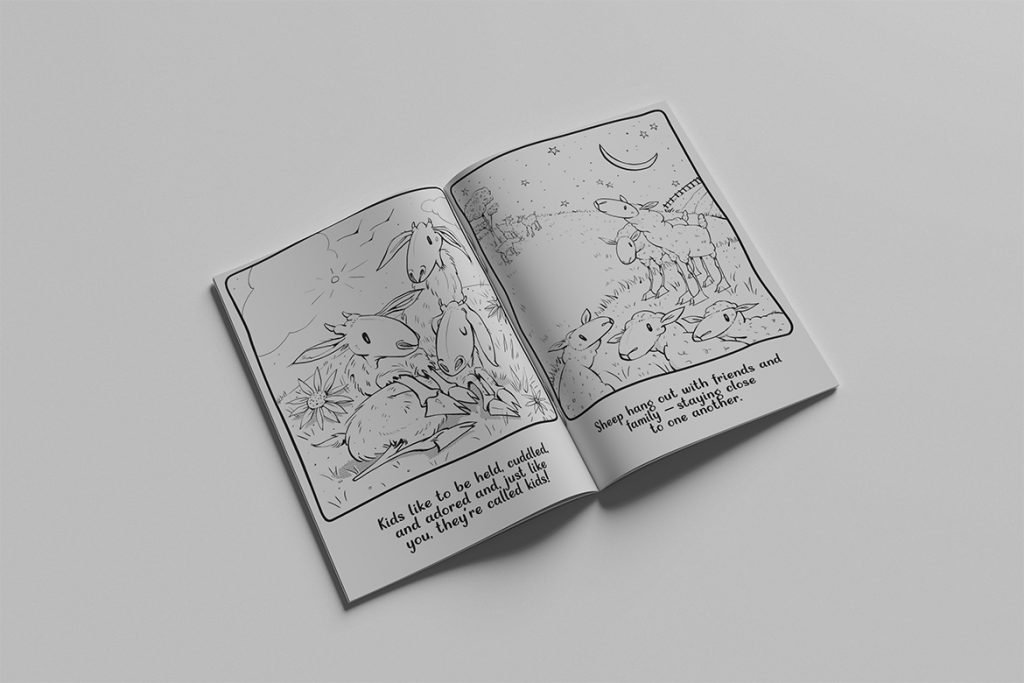
Zoe Fisher: I love that approach. It’s hard to change habits overnight, especially when options aren’t always accessible.
Eric Lindstrom: It’s getting better though. I’ve been vegan for 13 years. When I started, vegan options were rare, even in grocery stores or restaurants. Now you see plant-based products everywhere like Impossible Foods and Beyond Burgers. Even beyond the substitutes, about 90 percent of the grocery store is already vegan if you think about produce, pasta, spices, and canned goods. When people ask me for vegan recipes, I just tell them: cook what you normally cook, but use vegan ingredients. There’s a replacement for everything now.
Zoe Fisher: That makes it feel much more doable. Just swap brands, not your whole lifestyle overnight.
Eric Lindstrom: Exactly. It’s about changing brands and shifting perspective.
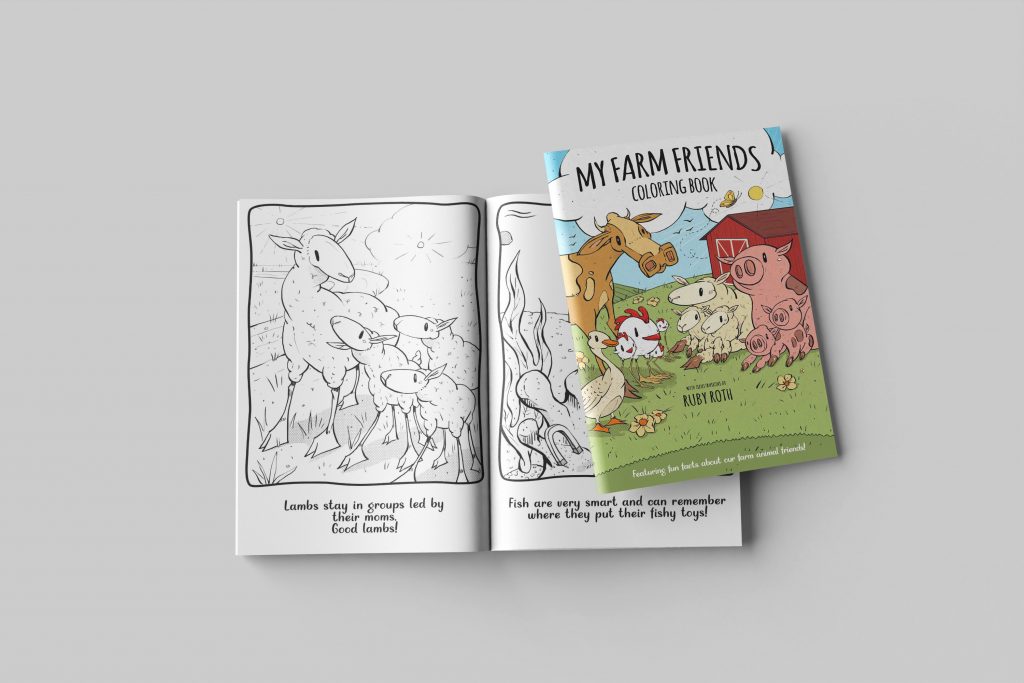
Zoe Fisher: What is the biggest challenge when trying to shift mindsets around animal rights?
Eric Lindstrom: The biggest challenges are habits and cultural backgrounds. People love their foods, their traditions, and there is often a cognitive dissonance, knowing something is wrong but continuing anyway. Even when people are exposed to the realities of factory farming, it is not always enough. Our work is about education and patience. There are programs like Veganuary, 10 Weeks to Vegan, and our MeatOut campaign that help people ease into it at their own pace. The key is showing it’s possible, not demanding perfection.
Zoe Fisher: It’s like anything, you need a smart goal and realistic steps to get there.
Eric Lindstrom: Exactly. Big changes happen in small, steady moves. Commit to a week. Try new foods. Realize you are not sacrificing, you are discovering. It is a lot easier today than it used to be, and we want to empower people to succeed without judgment.
Zoe Fisher: Have any of your campaigns stood out as especially impactful?
“Whether you are raising awareness, building community, or amplifying a cause, high-quality print can turn your mission into something tangible and unforgettable.” Eric Lindstrom, Executive Director
Eric Lindstrom: Definitely. Over the years, we have had protests, demonstrations, and online campaigns that reached hundreds of thousands. One campaign that made national news was MeatOut Day. When Governor Polis of Colorado proclaimed March 20th as MeatOut Day, it caused an uproar in an agricultural state. Farmers and ranchers created a counter-campaign called MeatIn Day. Ironically, their outrage amplified our message across the country. It was covered by the New York Times, Washington Post, and many others. Sometimes the controversy itself shows how powerful the idea really is.
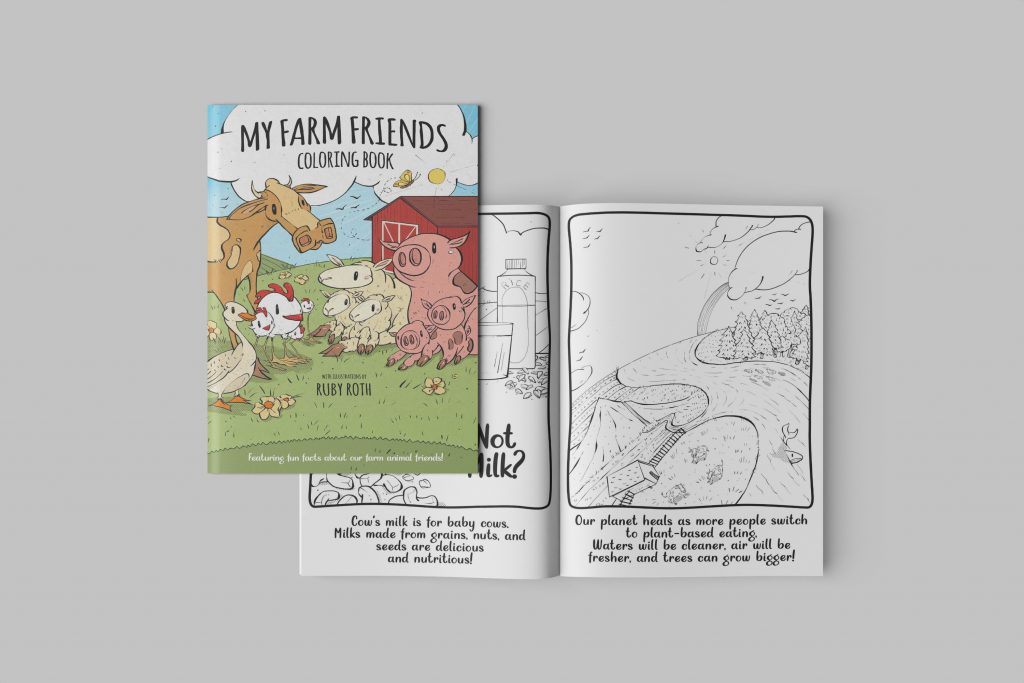
Zoe Fisher: That’s incredible. They tried to flip it, but you gained even more awareness.
Eric Lindstrom: Exactly.
Zoe Fisher: You mentioned using print materials like coloring books. Can you tell me more about how you use print to support your mission?
Eric Lindstrom: Print has always been essential for us. Even in a digital world, handing someone a brochure or a well-designed postcard is still powerful. We produce brochures like Bite Into a Better World, postcards comparing a dog and a cow to challenge perceptions, and educational materials for festivals and events. We also created a beautiful children’s coloring book with illustrator Ruby Roth. Instead of traditional farm narratives like milking cows, our book shows farm animals’ personalities, like chickens purring and piglets being playful. It plants seeds of compassion without heavy messaging. We initially printed 15,000 large-format coloring books, but they were expensive. That is when PrintingCenterUSA helped us scale it down affordably. Now we have a pocket-sized version with a semi-gloss cover and crayon-friendly interior, perfect for handing out at parades, pride events, and community gatherings. Print allows us to reach people where they are in a way that feels warm, not aggressive.
Zoe Fisher: I love that. It is accessible, creative, and perfectly scaled for nonprofits.
Eric Lindstrom: Exactly. And we are working toward getting these into mainstream family restaurants too, not just vegan spots.
Zoe Fisher: That would be amazing. I love the idea of kids connecting early and forming compassion naturally.
Eric Lindstrom: That is our goal. If a child names an animal, they are less likely to want to harm them.
We want to create those gentle, lasting impressions.
Zoe Fisher: What advice would you give to someone starting a nonprofit or advocacy group?
Eric Lindstrom: First, build good assets: high-quality images, approachable writing, strong design. People do not want to read a wall of text, so bullet points, clear headlines, and powerful visuals are key. Next, know your audience. Everything you design should resonate naturally with them. Finally, be smart with your printing budget. Use tools like ChatGPT to repurpose content for brochures, social captions, and blog posts efficiently. Good design should feel invisible. It should pull people in, not hit them over the head.
“Big changes happen in small, steady moves. Commit to a week. Try new foods. Realize you are not sacrificing, you are discovering.” Eric Lindstrom, Executive Director
Zoe Fisher: That is fantastic advice for nonprofits and small businesses alike.
Eric Lindstrom: Absolutely.
Zoe Fisher: How does fundraising work for FARM?
Eric Lindstrom: The biggest fundraising push is around Giving Tuesday at the end of November. It kicks off our end-of-year campaigns, which include email marketing, social media, and direct mail. For our mailers, we create colorful envelopes, business reply cards, executive letters, and highlight sheets. We send them to our top donors and hope for strong returns. About 90 percent of our donations go directly back into programming, like creating educational materials, funding MeatOut events, and printing new coloring books.
Zoe Fisher: Where can listeners donate if they want to support your work?
Eric Lindstrom: They can visit farmusa.org/donate or just click the donate button right on our homepage.
Zoe Fisher: I also have to ask. Do FARM employees have to be vegan?
Eric Lindstrom: Yes. Everyone on staff, and even our volunteers, must be vegan. We align with our mission completely.
Zoe Fisher: That makes perfect sense. Your values have to match your work.
Eric Lindstrom: Exactly.
Zoe Fisher: What do you hope someone takes away from this episode?
Eric Lindstrom: I hope they realize change is possible. Whether you go meatless on Mondays or commit fully to a plant-based diet, you can make a difference. It is not about sacrifice. It is about discovery, about living more compassionately and helping create a better world. Even one meal, one day at a time, matters.
Zoe Fisher: That is such a beautiful message.
Eric Lindstrom: Thank you.
Zoe Fisher: If you had a free day to spend however you wanted, what would you do?
Eric Lindstrom: Honestly, I would just be outside. I love springtime, the flowers, the trees blooming, the energy of renewal. I live in an area with lots of waterfalls, hiking trails, and gorges. A perfect day would be hiking, relaxing, and maybe, if I had more time, working on my third book.
Zoe Fisher: That sounds wonderful.
Eric Lindstrom: It really is.
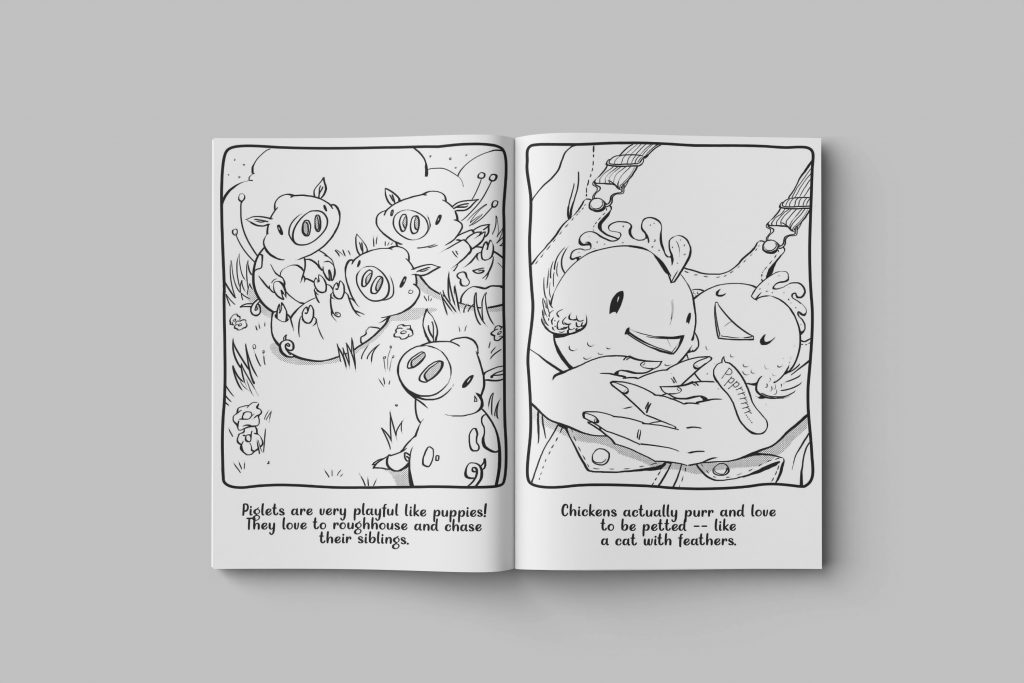
Zoe Fisher: Lastly, how can listeners stay connected with you and FARM?
Eric Lindstrom: Visit farmusa.org. Subscribe to our e-newsletter, shop our online store, or follow us on Facebook, X, Instagram, and YouTube. Even if you are not fully plant-based yet, there is so much you can learn and be inspired by.
Zoe Fisher: Thank you, Eric, and thank you to everyone listening.
“When people ask me for a vegan recipe, maybe they are having someone over for dinner and they’ve requested a plant-based menu, I always just tell them, choose whatever recipe you want to make and simply use vegan ingredients because there is a replacement for everything now.” Eric Lindstrom, Executive Director
That’s a wrap on another episode of Behind The Print. Thanks to our listeners for joining us as we explore the artistry and innovation of the printing world. Remember, have a strong vision, build the right strategy, and use tools like print to amplify your message and make your brand stand out.
If you enjoyed today’s episode, be sure to get your sample pack today from PrintingCenterUSA.com and share it with your fellow business enthusiasts. Until next time, keep your creative sparks flying, and remember, there’s always more to discover behind the print.
Where Print and Purpose Meet
From vibrant coloring books that spark compassion in children to outreach campaigns that educate and empower, Eric Lindstrom and the team at FARM are proving that print still holds incredible power in a digital world. By blending visual storytelling with strategic messaging, they show how printed materials can create real human connection and drive positive change. Whether you are raising awareness, building community, or amplifying a cause, high-quality print can turn your mission into something tangible and unforgettable. If you are ready to bring your own message to life, explore how impactful printing can support your goals with PrintingCenterUSA. Order today!



